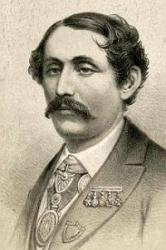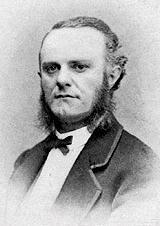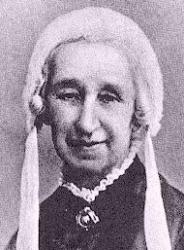Planning worship?
Check out our sister site, ZeteoSearch.org,
for 20+ additional resources related to your search.
- |
User Links
Person Results
‹ Return to hymnal




Export as CSV
Lucy Harrington
Person Name: H. L. Harrington Hymnal Number: 203 Author of "The Wanderer's Return" in Carols of Hope
Lucy Harrington
Melville W. Miller
Person Name: M. W. Miller Hymnal Number: 142 Author of "Filled With the Spirit" in Carols of Hope
Melville W. Miller
Susie Bradford Thompson
Hymnal Number: 150 Author of "One of These Little Ones" in Carols of Hope
Susie Bradford Thompson
Louis M. Gottschalk

1829 - 1869 Hymnal Number: 163 Composer of "[Holy Ghost, with light divine]" in Carols of Hope Louis Moreau Gottschalk USA 1829-1869. Born in New Orleans, LA, to a Jewish father and Creole mother, he had six siblings and half-siblings. They lived in a small cottage in New Orleans. He later moved in with relatives (his grandmother and a nurse). He played the piano from an early age and was soon recognized as a prodigy by new Orleans bourgeois establishments. He made a performance debut at the new St. Charles Hotel in 1840. At 13 he left the U.S. And went to Europe with his father, as they realized he needed classical training to fulfill his musical ambitions. The Paris Conservatory rejected him without hearing him play on the grounds of his nationality. Chopin heard him play a concert there and remarked, “Give me your hand, my child, I predict that you will become the king of pianists. Franz Liszt and Charles Valentin Alkan also recognized his extreme talent. He became a composer and piano virtuoso, traveling far and wide performing, first back to the U.S., then Cuba, Puerto Rico, Central and South America. He was taken with music he heard in those places and composed his own. He returned to the States, resting in NJ, then went to New York City. There he mentored a young Venezuelan student, Carreno, and became concerned that she succeed. He was only able to give her a few lessons, yet she would remember him fondly and play his music the rest of her days. A year after meeting Gottschalk, she performed for President Lincoln and went on to become a renowned concern pianist, earning the nickname “Valkyrie of the Piano”. Gottschalk was also interested in art and made connections with notable figures of the New York art world. He traded one of his compositions to his art friend, Frederic Church, for one of Church's landscape paintings. By 1860 Gootschalk had established himself as the best known pianist in the New World. He supported the Union cause during the Civil War and returned to New Orleans only occasionally for concerts. He traveled some 95,000 miles and gave 1000 concerts by 1865. He was forced to leave the U.S. later that year as a result of a scandelous affair with a student at Oakland Female Seminary in Oakland, CA. He never came back to the U.S. He went to South America giving frequent concerts. At one, in Rio de Janeiro, Brazil, he collapsed from yellow fever as he played a concert. He died three weeks later, never recovering from the collapse, possibly from an overdose of quinine or an abdominal infection. He was buried in Brooklyn, NY. Though some of his works were destroyed or disappeared after his death, a number of them remain and have been recorded by various artists.
John Perry
Louis M. Gottschalk
Lewis H. Redner

1831 - 1908 Hymnal Number: 165 Composer of "[O little town of Bethlehem]" in Carols of Hope Lewis Henry Redner (1831-1908) was born in Philadelphia, where he became a real estate agent and served on weekends as an organist and Sunday School Superintendent. He spent nineteen years at Holy Trinity church where Phillips Brooks was rector, and is credited with increasing attendance at the Sunday School from thirty-one to more than a thousand. In 1868 Brooks asked him to write a tune for his new text for children inspired by his recent trip to Bethlehem. Redner composed the tune the night before it was to be sung in worship on Sunday morning. The text and tune were first published in 1894 in The Church Porch, where the tune was named ST. LOUIS, possibly after the composer’s name. Redner is remembered today because of this one tune that has remained a Christmas favorite.
Emily Brink
Lewis H. Redner
Robert Lowell
1816 - 1891 Hymnal Number: 164 Adapter of "Carol, Children" in Carols of Hope
Robert Lowell
F. F. Flemming

1778 - 1813 Hymnal Number: 53 Composer of "[Praise ye the Father, for his loving kindness]" in Carols of Hope Friedrich Ferdinand Flemming Germany 1778-1813. Born in Neuhausen, Erzgebirge, Germany, he studied medicine at Wittenberg, 1796-1800, Jena, Vienna, and Trieste. He practiced as a physician in Berlin until his death, but, musically, is remembered for his setting of Horace's ode beginning “Integer Vitae”, from which the tune “Flemming” is adapted. He was active in musical circles and composed many songs for a male vocal ensemble, “Liedertafel”. He died in Berlin.
John Perry
F. F. Flemming
Jemima Luke

1813 - 1906 Hymnal Number: 65 Author of "I Think, When I Read" in Carols of Hope Luke, Jemima Thompson, the wife of Rev. Samuel Luke, an Independent minister of England, was the daughter of Thomas 422 Thompson, a philanthropist, and was born at Colebrook Terrace, Islington, August 19, 1813. When only thirteen years of age she began writing for the Juvenile Magazine. She published a volume titled The Female Jesuit in 1851 and A Memoir of Eliza Ann Harris, of Clifton, in 1859, but her name is known to the Christian world almost wholly through the one hymn found in this volume. Mrs. Luke died February 2, 1906.
I think when I read that sweet 682
Hymn Writers of the Church, 1915, Charles Nutter
===============
Luke, Jemima, née Thompson, daughter of Thomas Thompson, sometime of Bath, was born at Colebrooke Terrace, Islington, Aug. 19, 1813, and was married to the late Samuel Luke, a Congregational Minister, in 1843. She was an anonymous contributor to The Juvenile Magazine at the age of 13, and subsequently pub. several works, including The Female Jesuit, 1851; A Memoir of Eliza Ann Harris, of Clifton, 1859, &c. Mrs. Luke is known to hymnody through her hymn:—
I think when I read that sweet story of old. [The Love of Jesus.] It is recorded that this hymn was composed in a stage coach in 1841, and was designed for use in the village school, near her father's seat, Poundsford Park. It was published anonymously in the Leeds Hymn Book, 1853, No. 874, in 3 stanzas of 8 lines, and has since come into use through children's hymn-books in most English-speaking countries.
--John Julian, Dictionary of Hymnology (1907)
Jemima Luke


 My Starred Hymns
My Starred Hymns

